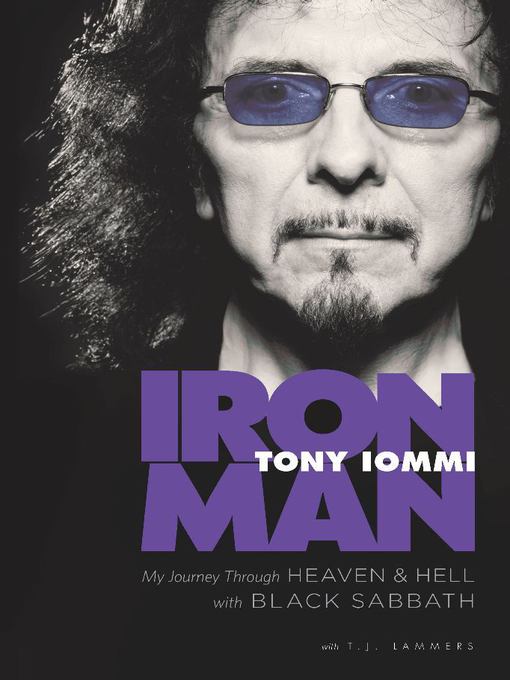
Iron Man
My Journey through Heaven and Hell with Black Sabbath
فرمت کتاب
ebook
تاریخ انتشار
2011
نویسنده
Symbolonنویسنده
Sharyl Jupeنویسنده
Symbolonنویسنده
Sharyl Jupeنویسنده
T. J. Lammersناشر
Da Capo Pressشابک
9780306820540
کتاب های مرتبط
- اطلاعات
- نقد و بررسی
- دیدگاه کاربران
نقد و بررسی

October 3, 2011
While there are other books that offer more detail about the band, lead guitarist and songwriter Iommi’s chronicle is an important addition to the Black Sabbath story. Even early Sabbath detractors recognized that Iommi’s pummeling riffs in songs like “Iron Man” and “War Pigs”—powerfully delivered by lead singer Ozzy Osborne—defined the Sabbath sound. Iommi’s autobiography is as direct as his music, beginning with his description of losing the two middle fingers on his left hand in an industrial press accident as a teenager in the early days of the band, which, he notes, some people credit with creating “the deeper, down-tuned sound” of the band—“I had to reinvent my style of playing to accommodate the pain.” The book’s main virtue is its straightforward, year-by-year account of the band’s history, from early struggles (“When we recorded Paranoid I still lived at home”) through the band’s breakup with Ozzy in 1979 (“There were so many drugs flying around, coke and Quaaludes and Mandrax, and there was booze and late nights and women and everything else”) to Iommi’s post-Ozzy versions of Sabbath and various solo projects.

October 1, 2011
Black Sabbath's founding guitarist recounts the British metal band's chaotic history. Iommi's as-told-to book, co-authored by T.J. Lammers, offers a rote look at his foundational group's story, which practically ended before it began. At 17, the aspiring axe man sliced off two fingertips while operating a machine press. Inspired by the example of gypsy virtuoso Django Reinhardt, who performed brilliantly after his hand was severely burned, Iommi continued to play, with self-fabricated "thimbles" extending his digits. He soon hooked up with three other Birmingham, England, lads--singer Ozzy Osbourne, bassist Geezer Butler and drummer Bill Ward--to form Black Sabbath, whose churning, down-tuned music drew the metal road map. Iommi, the band's resident riff-master and studio obsessive, unimaginatively recalls the band's story album by album and tour by tour, without explicating the group's unique sound, internal chemistry or propensity for provoking public outrage. He's most entertaining when describing the Sabbath's incessant, hazardous prank-playing; much of the "fun" came at the expense of Ward, who was nearly suffocated by a coat of gold spray paint and almost fatally incinerated after Iommi doused him with tape-machine head cleaner and set him ablaze. The guitarist is not wholly unaware of the oft-ludicrous nature of his enterprise: One of the best chapters recalls the building of a massive, misbegotten Stonehenge stage set, which inspired a choice gag in This is Spinal Tap. But he is unable to shed light on the band mates' fraught relationships (exacerbated by drug and alcohol abuse), Sabbath's hellish business affairs or his own chronic cocaine use and failed marriages. Excepting a rich passage about a once-unthinkable 2002 command performance before Queen Elizabeth II, the late going devolves into an unenlightening recap of the band's revolving-door post-Osbourne years, when it was fronted by singers Ronnie James Dio, Ian Gillan and others, and its latter-day reunion gigs. However, readers do learn that Michael Bolton unsuccessfully auditioned for the position of lead vocalist. As rock bios go, this just isn't heavy enough.
(COPYRIGHT (2011) KIRKUS REVIEWS/NIELSEN BUSINESS MEDIA, INC. ALL RIGHTS RESERVED.)

November 15, 2011
Surprisingly, the man who invented the heavy-metal riff didn't do it out of creative inspiration but out of prosthetic necessity. Detailing the gruesome accident that resulted in the severing of two fingers on his left hand, Iommi opens his memoir with both graphic description and honesty. It was this event that shaped his style of guitar playing and the sound that was to define Black Sabbath. While much of his memoir details the trials and tribulations of Black Sabbath, Iommi paints an intimate portrait of his own life from childhood to his most recent musical effort in Heaven & Hell. Aided by journalist Lammers, Iommi's narrative voice is evident in each vignette. Unfortunately for Iommi, the book ends in the same way it begins: with another accident, this one involving his right hand. Still, even with two damaged hands, Iommi reminds us that he is one of the greatest guitar legends alive today. VERDICT Another rock 'n' roll memoir rife with addiction and celebrity. Readers who enjoyed Joel McIver's Sabbath Bloody Sabbath will be drawn to Iommi's insider perspective.--Joshua Finnell, Denison Univ. Lib., Granville, OH
Copyright 2011 Library Journal, LLC Used with permission.

November 1, 2011
Some people believe guitarist Iommi, the only founding member of Black Sabbath who's remained with the group all along, accidentally created heavy metal. A mishap with a metal-bending machine in a welding shop snipped off two of his fingertips, which changed how he played, but was the accident really responsible for the birth of a new style of music? Well, that's too bloody much, says Iommi. On the other hand, no one can deny that Iommi and his bandmates, including lead singer Ozzy Osbourne, created something fresh, exciting, and just a little bit subversive. This memoir, dead certain to appeal to heavy-metal fans of all ages, tracks Iommi's life and the history of Black Sabbath. Predictably, given its subject, it's full of drugs, booze, and controversy, but Iommi makes no apologies for that. It's his life, the way he lived it. With plenty of behind-the-scenes stories and fresh perspectives on some of music's most notorious characters (including, again, Ozzy), this is a frank and honest look at a special part of rock history.(Reprinted with permission of Booklist, copyright 2011, American Library Association.)

























دیدگاه کاربران